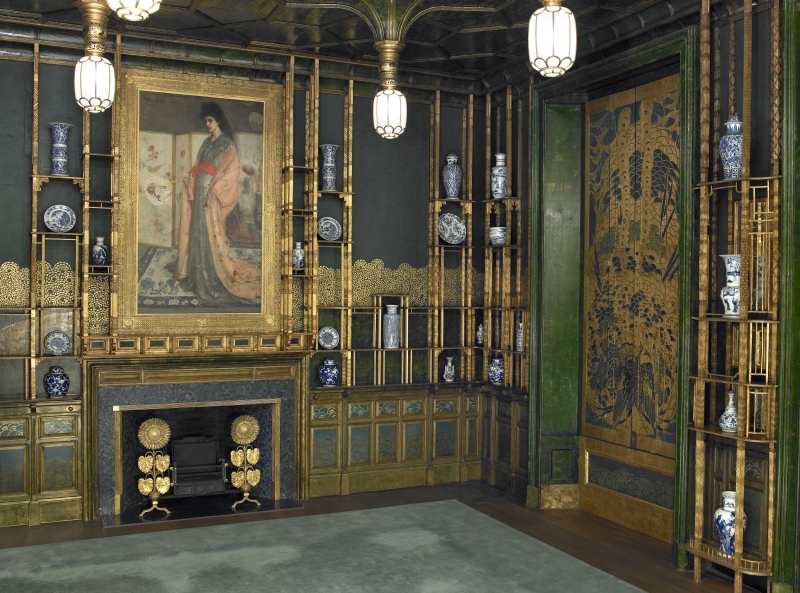Home > Catalogue > Browse > Harmony in Blue and Gold: The Peacock Room << >>
Titles
The title 'Harmony in Blue and Gold: The Peacock Room' was used by Whistler from the beginning, and is the preferred title. 1 This remains the full title of what is commonly shortened to 'The Peacock Room'. 2
Description
Peter Ferriday gives a full description of Jeckyll's designs for the dining room: the incised, Oriental-looking shelving was effective; the Jacobean pendant ceiling, fitted to hold gas lights, was heavy and incongruous, but matched other ceilings in the house; the andirons were sunflowers, borrowed from one of Jeckyll's most successful works, the Pavilion he designed for Barnard's at the Philadelphia Exhibition of 1876. 3 Following the example of Cyril Flower (1843-1907), later Lord Battersea, who had 'a room hung with Spanish leather in which there was Blue and White [china]', Murray Marks (1840-1918) recommended gilt leather for the walls and acquired it for Leyland's residence at a cost of £1000. 4
Whistler's own description, which he published in a leaflet for visitors of the recently (almost) finished Peacock Room, focused on pattern and colour:
'HARMONY IN BLUE AND GOLD.
THE PEACOCK ROOM
The Peacock is taken as a means of carrying out this arrangement.
A pattern, invented from the Eye of the Peacock, is seen in the ceiling spreading from the lamps. Between them is a pattern devised from the breast-feathers.
These two patterns are repeated throughout the room.
In the cove, the Eye will be seen running along beneath the small breast-work or throat-feathers.
On the lowest shelf the Eye is again seen, and on the shelf above – these patterns are combined: the Eye, the Breast-feathers, and the Throat.
Beginning again from the blue floor, on the dado is the breast-work, BLUE ON GOLD, while above, on the Blue wall, the pattern is reversed, GOLD ON BLUE.
Above the breast-work on the dado the Eye is again found, also reversed, that is GOLD ON BLUE, as hitherto BLUE ON GOLD.
The arrangement is completed by the Blue Peacocks on the Gold shutters, and finally the Gold Peacocks on the Blue wall.' 5
George Charles Williamson (1858-1942) remarks that the Peacock Room appeared to best effect 'by artificial light, when the shutters, which formed an integral part of the scheme were closed.' However, he says that Leyland regretted the loss of the original scheme, because Jeckyll's slender shelving looked fine with the collection of blue and white porcelain against the leather, whereas less porcelain could be exhibited with Whistler's decoration. 6
Site
The original site of the room was 49 Princes Gate in London. 7
The Peacock Room was disassembled several times: in 1904 Obach & Co. dismantled it and exhibit it on their own premises in London, after which it was disassembled and shipped to Detroit for Charles Lang Freer (1856-1919). It was dismantled again before being installed at the Freer Gallery of Art in Washington DC in 1920. 8
Sitter
The fighting peacock on the right is a crypto-portrait of Frederick Richards Leyland (1832-1892), made recognisable by the silver coins on its chest, which refer both to Leyland’s habit of wearing frilled shirts and to his refusal to pay Whistler the additional £1000 he had asked for. 9
Notes:
1: Academy, 17 February 1877 [more], at p. 147.
2: The title's first appearance in the press dates from January 1877, see Leeds Mercury, 6 January 1877 [more]; Merrill 1998 [more].
3: Ferriday 1959 [more], at pp. 411-12.
4: Pennell 1921C [more], p. 109.
6: Williamson 1919 [more], pp. 94-95.
7: For the history of the site and building see British History Online: Princes Gate and Princes Gardens, website at http://www.british-history.ac.uk.
8: Merrill 1998, op. cit., p. 348.
9: Leyland’s ruffled shirtfronts had become his well-known attribute. See Merrill 1998 [more], p. 128.
Last updated: 20th May 2021 by Margaret






